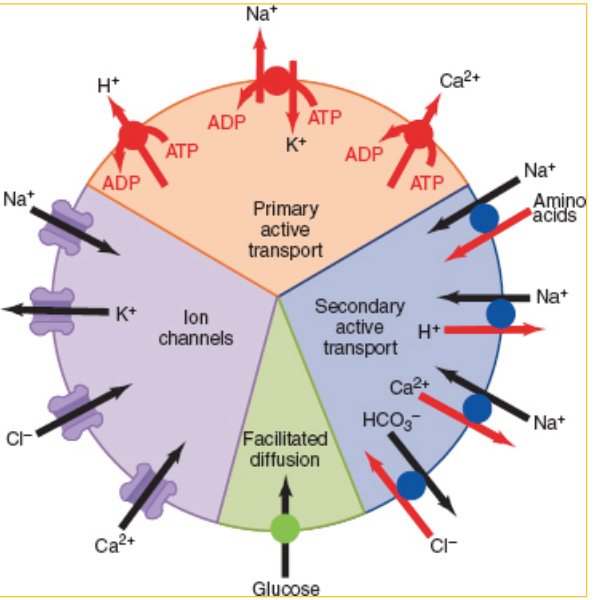4 & 5 Human Physiology
4.1 Diffusion
- Simple diffusion: Random movement of molecules due to thermal motion
- Net diffusion: Always occurs down a concentration gradient
- Diffusion does not require energy nor binding to a transporter protein
- Flux: The amount of a substance crossing a membrane per unit time
- Net flux: The difference between two one-way fluxes
- The magnitude of diffusion flux across a membrane is determined by
- Concentration gradient
- Bigger difference in concentraion increases flux
- Temperature
- Higher temperature increases flux
- Mass of molecule
- Larger molecules have a harder time diffusing
- Surface area of membrane
- Larger surface area makes more opportunity for substances to permeate
- Diffusion medium
- Easier travel through water than oil
- Diffusion distance
- Smaller distance traveled means more flux
- Membrane permeability
- Lipid bilayer: The limiting factor for diffusion across cell membranes
- Simple diffusion: The type of diffusion by while non-polar molecules readily move
- Polar or charged molecules cannot readily cross a cell membrane via simple diffusion
Channel Diffusion
- Ions can only move down a concentration gradient if channels are present in the plasma membrane
- Ion Channels
- Ion channels allow downhill movement of ions
- Ion channels do not require binding
- Ion channels can either be open or closed to allow movement
- Ion channels are selective for their specific ions (sodium vs potassium channels)
- Movement of ions across membrane influenced by electrical gradient as well as concentration gradient
- Inside of cell has negative membrane potential
- Intracellular fluid attracts cations and repels anions
- Electrochemical gradient: The net flux in and out of a cell is ultimately determined by this gradient.
- Regulation of ion channels (aka gates)
- Ligand-gated: Cell membrane channels that open on one side of the cell membrane to open or close to passage
- Voltage-gated: Channels that rely on electrical signals to move open or closed
- Mechanically-gated channels: Channels of a cell membrane that must move themselves open or closed using energy
- Leak: Non-gated cell membrane channels
Osmosis
- Osmosis: Net diffusion of water from a region of higher water concentration to a region of lower concentration
- Water concentration is inverselyrelated to solute concentration
- Osmolarity: total moles of solute divided by Liters of solution
- Aquaporins: Channels that allow the rapid passage of water through the cell membrane, necessary because water is polar
- Permeable: If a membrane is fully _ to water and solute, both will eventually reach equilibrium
- Semi-permeable: If membrane is _ (only permeable to water), water will move to area of higher solute concentration
Mediated Transport
Mediated transport: The process by which the solute moves by binding to a transmembrane protein known as a transporter
Mediated transport flux is affected by number of transporters, affinity of transporters, and the rate of transporter conformation change
Facilitated diffusion, active transport: Two broad categories of mediated transport
Facilitated diffusion: A type of mediated transport that involves downhill movement, no energy required
- In facilitated diffusion, Net flux continues until equilibrium reached
Active transport: A type of mediated transport that involves uphill movement and requires energy (ATP)
- Primary: This Active Transport type occurs when energy comes directly from ATP hydrolysis
- A sodium/potassium ATPase pump is an example of Primary Active Transport
- Secondary: This Active Transport type occurs when energy comes from an existing ion gradient
- Cotransport: A type of secondary active transport; Transported substance can move in same direction as Na+ and it kinda hitches a ride
- Countertransport: A type of secondary active transport; Transported substance can move in opposite direction as Na+ where it kinda sneaks against the sodium flow

Endo & Exocytosis
- Some substances enter/exit cell without passing through cell membrane or membrane-transporter, which is endo or exocytosis
- Endocytosis: Cell membrane folds in from the outside to create a baby pocket, losing some cell membrane and requiring ATP, and is generally used for bulk movement.
- Endocytosis moves stuff into the cell
- Pinocytosis, phagocytosis, and receptor-mediated endocytosis are all types of endocytosis
- Exocytosis: Vesicle fuses to te cell membrane to release stuff outside of the cell; replaces the membrane it lost during endocytosis; most secreted substances come from the Golgi apparatus
- \